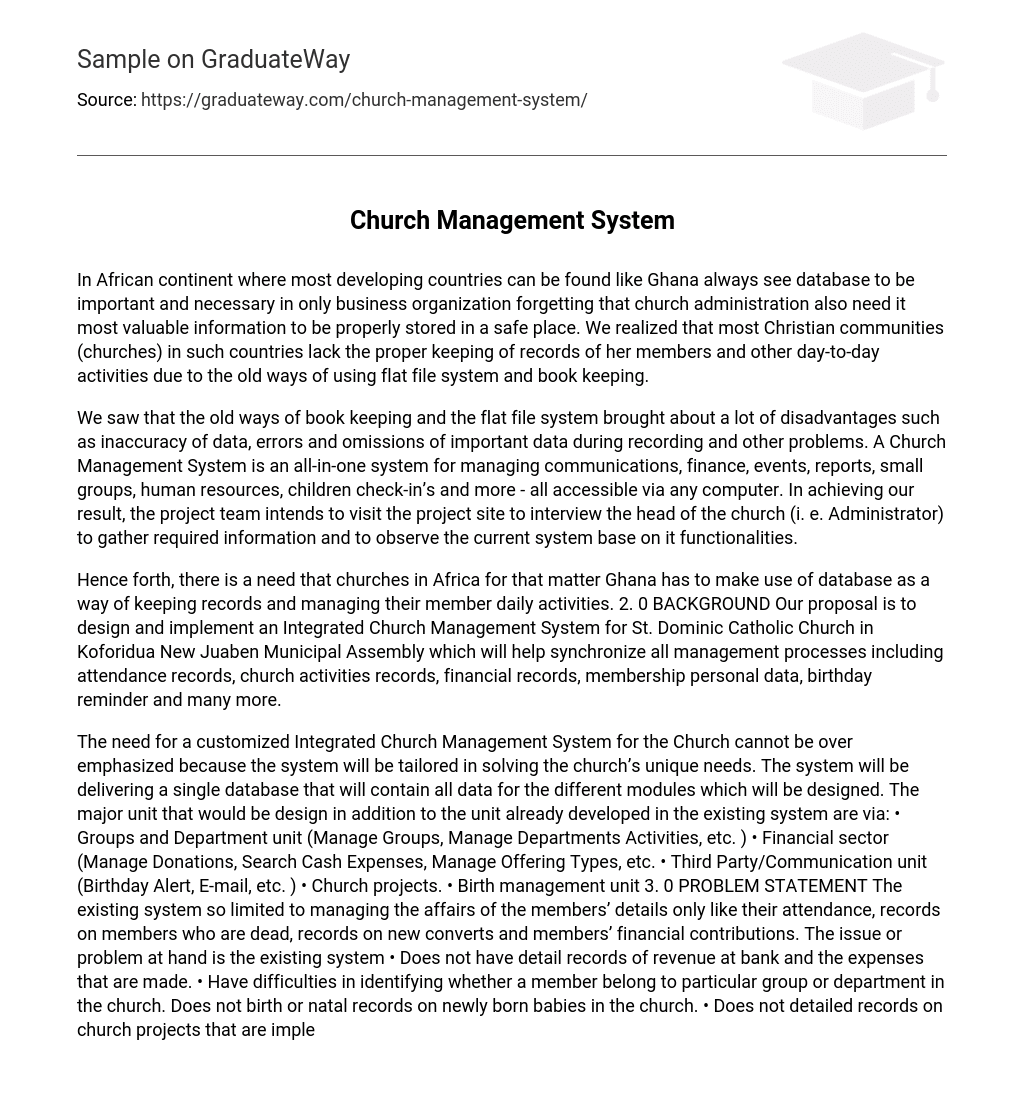In countries like Ghana, which are located in the African continent and are primarily developing, the significance and necessity of a database are often emphasized solely in the context of business organizations. However, it is crucial to recognize that church administration also greatly requires a reliable storage system for valuable information. Sadly, many Christian communities in these countries still rely on outdated methods such as the flat file system and bookkeeping, resulting in inadequate record-keeping of their members and day-to-day activities.
The disadvantages of traditional bookkeeping methods and flat file systems, which include inaccurate data, errors, and the omission of crucial information during recording, have been noticed. A Church Management System is a complete solution for managing different aspects such as communication, finances, events, reports, small groups, human resources, and children check-ins. This system can be accessed from any computer. In order to achieve our objective, the project team plans to visit the project site and interview the church’s head (also known as Administrator) in order to collect necessary information and gain an understanding of how the current system functions.
We suggest implementing an Integrated Church Management System for St. Dominic Catholic Church in Koforidua New Juaben Municipal Assembly, Ghana, and other churches in Africa. This system will utilize a database to effectively maintain records and manage the daily activities of church members. It will synchronize various management processes such as attendance records, church activity records, financial records, membership personal data, birthday reminders, and more.
The Church acknowledges the significance of a tailored Integrated Church Management System that caters to its specific requirements. This system will encompass a central database containing data for various modules, in addition to the current unit. These new units will comprise management for Groups and Departments, Financial sectors, Third Party/Communication features, Church projects, and Births. Currently, the existing system solely handles member attendance, records of deceased members and new converts, as well as financial contributions. However, there are multiple issues with this system including inadequate detailed bank revenue and expense records, difficulties in identifying member affiliations with groups or departments, absence of birth records for newborns in the church, and incomplete documentation on implemented church projects. As a result, our proposed system aims to address these problems by offering personalized support to St Dominic Catholic Church’s congregation members. Our objective is to achieve this by ensuring convenient access to information regarding each individual’s background and monitoring church performance for analysis purposes. The system will resolve record-keeping concerns through managing all financial records and establishing efficient birthday alerts for members and children. This will assist in maintaining an inventory of church incomes and expenditures while allowing vigilance against corruption or misuse of funds.In addition, the system’s ability to provide natal or birth records will enable monitoring and regulation of the birth rate within both the church and the entire country.
The system will automatically record each member’s birthday without requiring their date of birth during congregations, which will create a surprise when presenting gifts to members celebrating their birthdays.
6.0 SCOPE
To achieve our objectives, we will:
- Meet with the St Dominic church Administrator.
- Visit and assess the current system(s) in place.
- Implement Church Management Software and test it.
- Train users on how to use the application.
- Provide post-implementation support.
7.0 METHODOLOGY
The text states that the system will automatically record each member’s birthday without needing their date of birth during congregations, leading to a surprise when giving gifts to members celebrating their birthdays. The scope of the project includes meeting with the St Dominic church Administrator, assessing the current systems in place, implementing and testing Church Management Software, training users on its usage, and providing post-implementation support.
According to our objective, the research team plans to use the waterfall model as the method or process for developing our system. In line with the waterfall model, our intention is to gather information and analyze feedback from users of the current system through visits and interactions.
9.0 REFERENCES
1. Jennifer Schuchmann (March 1, 2002). Your Church magazine (Christianity Today): p. 54.
2. http://complustech.net/ChurchPlus.pdf
3. http://enrichmentjournal.ag.org/200304/070_tech03_software_sb.cfm
4. http://www.communicatejesus.com/2012/06/selecting-a-church-member-database-part-1/





